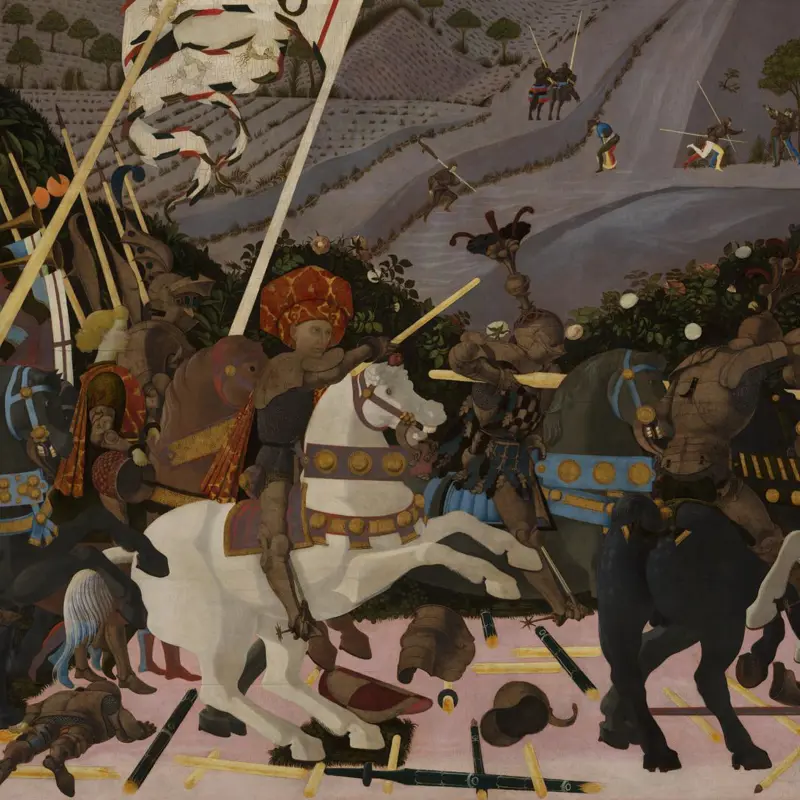The National Gallery celebrated the 20th Anniversary of the Sainsbury Wing in 2011.
The Sainsbury Wing was opened by Queen Elizabeth II on 9 July 1991. The building was presented to the nation by the three Sainsbury brothers – John, Simon and Timothy – and over the past 20 years it has offered millions of visitors a fitting space in which to contemplate the National Gallery’s outstanding collection of early Renaissance paintings.
Building history
Transcript
Written and narrated by Alan Crookham
The Sainsbury Wing was opened by Queen Elizabeth II on 9 July 1991. Intended as a new home for the National Gallery’s world-class collection of early Renaissance paintings, its opening was a moment of celebration, both for the Gallery and the donors who had so generously funded the project. However, the prospects for the site had not always been so propitious.
Its former occupant, Hampton’s Furniture Store, was destroyed by fire during the Blitz in 1940 and, although a temporary shop re-opened on the site after the war, by the late 1950s the area had become a waste-ground.
In 1958 the Government acquired the Hampton Site as a possible location for an extension to the National Gallery, but plans to develop the plot came to nothing and it remained empty – an old bomb site which was destined to be no more than a car park for decades to come.
It was only in 1981 that an agreement was finally reached which enabled the Secretary of State, Michael Heseltine, to launch a competition for the design of the new extension.
Seven entries were shortlisted:
- Ahrends, Burton and Koralek (ABK)
- Richard Sheppard, Robson and Partners
- Covell Matthews Wheatley
- Skidmore, Owings and Merrill
- Raymond Spratley Partnership
- Arup Associates
- Richard Rogers
The winning architects were ABK, but their revised design stirred up controversy when in May 1984 Prince Charles criticised it as a ‘monstrous carbuncle on the face of a much-loved and elegant friend.’
Prince Charles’s view was echoed by many among the general public and in the Press. Ultimately, the ABK design was refused planning permission in September 1984 and the proposal to extend the National Gallery came to a halt.
A halt, that is, until April 1985 when the generosity of the three Sainsbury brothers – Simon, John and Timothy – revived the proposed extension after it was announced that the Sainsburys would fund a new wing entirely for the use of the Gallery.
A new search for an architect began and a shortlist of six was drawn up:
- Harry Cobb
- Colquhoun and Miller
- Jeremy Dixon
- Piers Gough
- James Stirling
- Robert Venturi
It was Venturi who was revealed to the world as the National Gallery’s preferred architect in January 1986.
Venturi perfected his designs according to the Gallery’s brief, paying particular care to ensure that the space would be appropriate for the early Renaissance paintings. The difficulties faced by the architects are explained here by the Gallery’s director Nicholas Penny.
Nicholas Penny: One of the problems that one has hanging the earliest paintings in the National Gallery is that they are some of the largest pictures – the great altarpieces – and some of the smallest, those that come from domestic chests and small devotional paintings intended to be looked at in private. And the architects have solved the problem that we have in displaying these works by having very large openings so you are always aware when you are in one room of a sequence of rooms beyond – and so this great sequence of rooms recalls the space of a great church without in any way imitating it. And that suits great altarpieces very well. They can be seen from afar and you feel they have something of the ecclesiastical context from which they were removed. But at the same time the plan of these galleries as individual rooms is quite small and I think it’s very conducive to the contemplation of small works of art.
Narrator: In January of the following year construction began, with the ceremony to lay the foundation stone of the Sainsbury Wing, taking place in the presence of the Prince and Princess of Wales on 30 March. The reinforced concrete structure was completed the following year and marked by the event known as the Topping Out ceremony. The structure was then made weathertight before work began on finishing the inside of the building, and the whole was unveiled in December 1990 and finally opened to the public by Queen Elizabeth II the following July.
From the outset, the Sainsbury Wing had been planned as a space where the Gallery could breathe new life into the display of its outstanding collection of early Renaissance paintings. The public could now view the earliest paintings in the collection in a broadly chronological sequence in which pictures from southern and northern Europe were no longer separated but were placed in adjoining rooms. These paintings, mostly religious and devotional pictures or early portraiture, could now be enjoyed in a series of galleries whose interiors are reminiscent of the Italian churches in which many of them would originally have been housed.
Twenty years after it first opened, externally the Sainsbury Wing has become part of the fabric of Trafalgar Square, while inside it continues to fulfil its role as a fitting home for one of the world’s greatest collections of early Renaissance paintings.
















